Reflective Journal: Intravenous Injection and Nursing Practice
VerifiedAdded on 2023/04/20
|6
|1366
|148
Journal and Reflective Writing
AI Summary
This reflective journal entry details a nursing student's experience administering an intravenous injection of Ceftriaxone to a 72-year-old patient post-knee surgery who developed an infection. The student describes initial nervousness and difficulty finding the vein, leading to multiple attempts and patient agitation. Feelings of relief after successful administration were overshadowed by disappointment and lowered self-confidence. A critical evaluation reveals strengths in medication verification and communication, but a failure to administer the injection smoothly. Analysis attributes the difficulties to nervousness and lack of confidence. The student concludes by outlining an action plan to improve intravenous administration skills through observation, literature review, and enhanced communication, aiming for more effective and patient-centered care. The student also intends to review NSQHS guidelines and the Australian Nursing and Midwifery code of conduct.
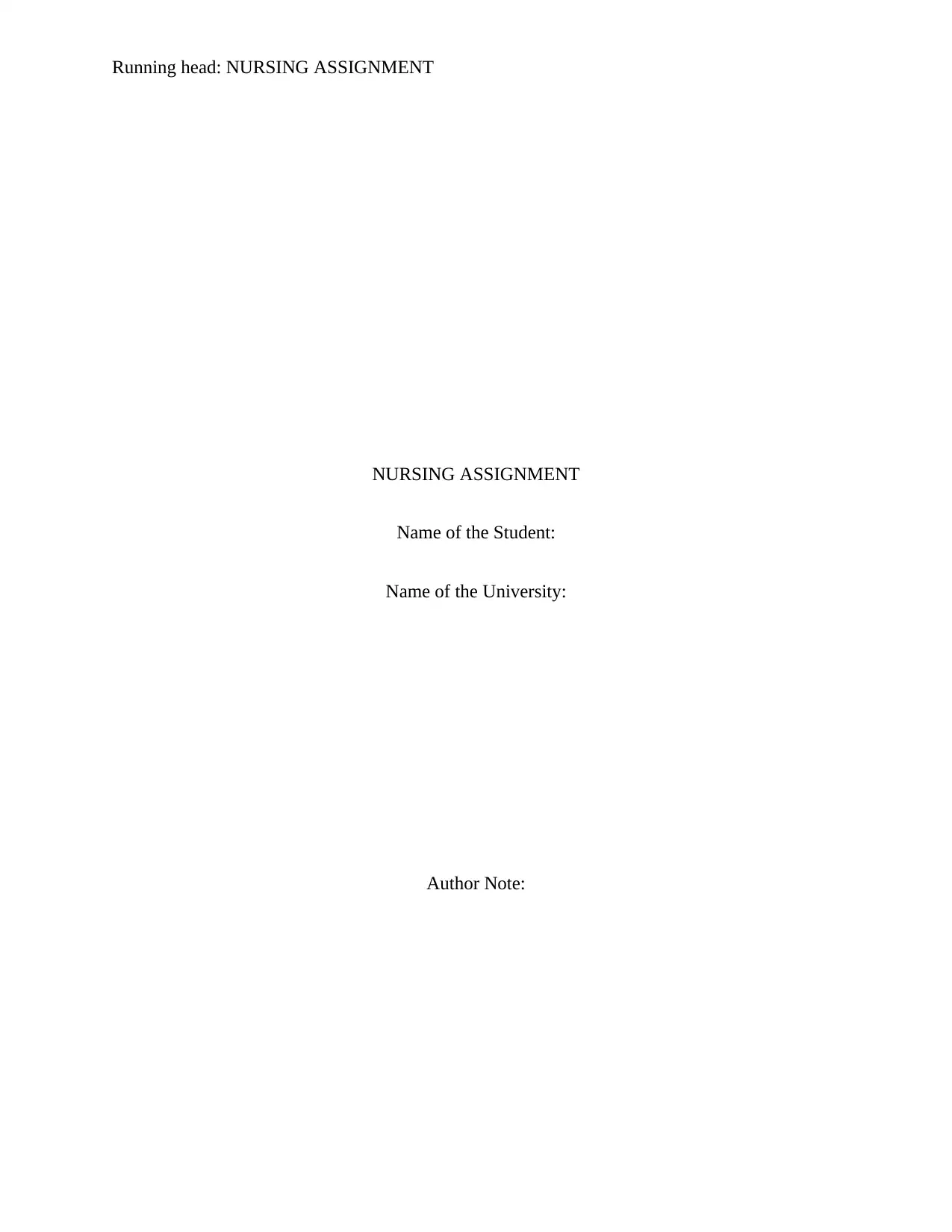
Running head: NURSING ASSIGNMENT
NURSING ASSIGNMENT
Name of the Student:
Name of the University:
Author Note:
NURSING ASSIGNMENT
Name of the Student:
Name of the University:
Author Note:
Paraphrase This Document
Need a fresh take? Get an instant paraphrase of this document with our AI Paraphraser
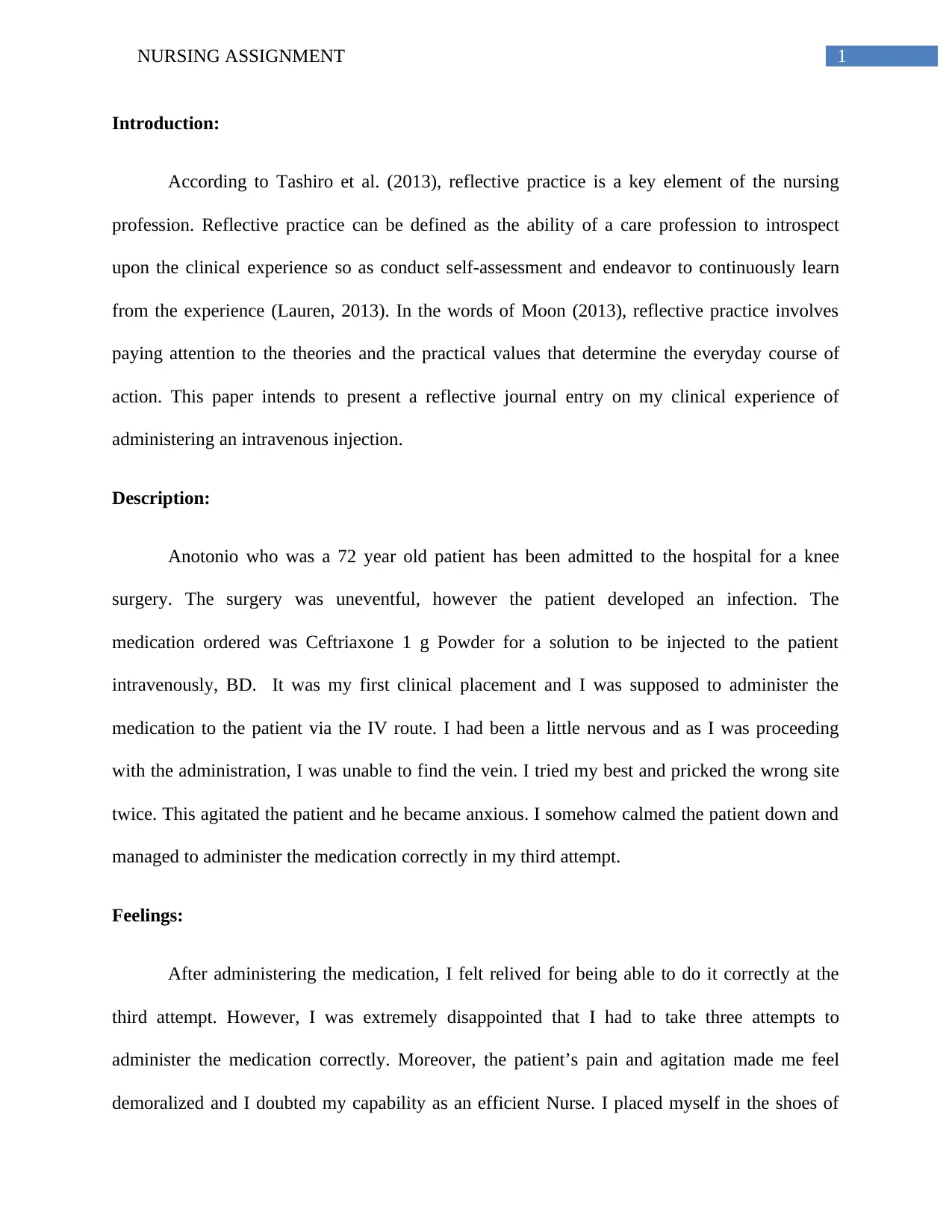
1NURSING ASSIGNMENT
Introduction:
According to Tashiro et al. (2013), reflective practice is a key element of the nursing
profession. Reflective practice can be defined as the ability of a care profession to introspect
upon the clinical experience so as conduct self-assessment and endeavor to continuously learn
from the experience (Lauren, 2013). In the words of Moon (2013), reflective practice involves
paying attention to the theories and the practical values that determine the everyday course of
action. This paper intends to present a reflective journal entry on my clinical experience of
administering an intravenous injection.
Description:
Anotonio who was a 72 year old patient has been admitted to the hospital for a knee
surgery. The surgery was uneventful, however the patient developed an infection. The
medication ordered was Ceftriaxone 1 g Powder for a solution to be injected to the patient
intravenously, BD. It was my first clinical placement and I was supposed to administer the
medication to the patient via the IV route. I had been a little nervous and as I was proceeding
with the administration, I was unable to find the vein. I tried my best and pricked the wrong site
twice. This agitated the patient and he became anxious. I somehow calmed the patient down and
managed to administer the medication correctly in my third attempt.
Feelings:
After administering the medication, I felt relived for being able to do it correctly at the
third attempt. However, I was extremely disappointed that I had to take three attempts to
administer the medication correctly. Moreover, the patient’s pain and agitation made me feel
demoralized and I doubted my capability as an efficient Nurse. I placed myself in the shoes of
Introduction:
According to Tashiro et al. (2013), reflective practice is a key element of the nursing
profession. Reflective practice can be defined as the ability of a care profession to introspect
upon the clinical experience so as conduct self-assessment and endeavor to continuously learn
from the experience (Lauren, 2013). In the words of Moon (2013), reflective practice involves
paying attention to the theories and the practical values that determine the everyday course of
action. This paper intends to present a reflective journal entry on my clinical experience of
administering an intravenous injection.
Description:
Anotonio who was a 72 year old patient has been admitted to the hospital for a knee
surgery. The surgery was uneventful, however the patient developed an infection. The
medication ordered was Ceftriaxone 1 g Powder for a solution to be injected to the patient
intravenously, BD. It was my first clinical placement and I was supposed to administer the
medication to the patient via the IV route. I had been a little nervous and as I was proceeding
with the administration, I was unable to find the vein. I tried my best and pricked the wrong site
twice. This agitated the patient and he became anxious. I somehow calmed the patient down and
managed to administer the medication correctly in my third attempt.
Feelings:
After administering the medication, I felt relived for being able to do it correctly at the
third attempt. However, I was extremely disappointed that I had to take three attempts to
administer the medication correctly. Moreover, the patient’s pain and agitation made me feel
demoralized and I doubted my capability as an efficient Nurse. I placed myself in the shoes of
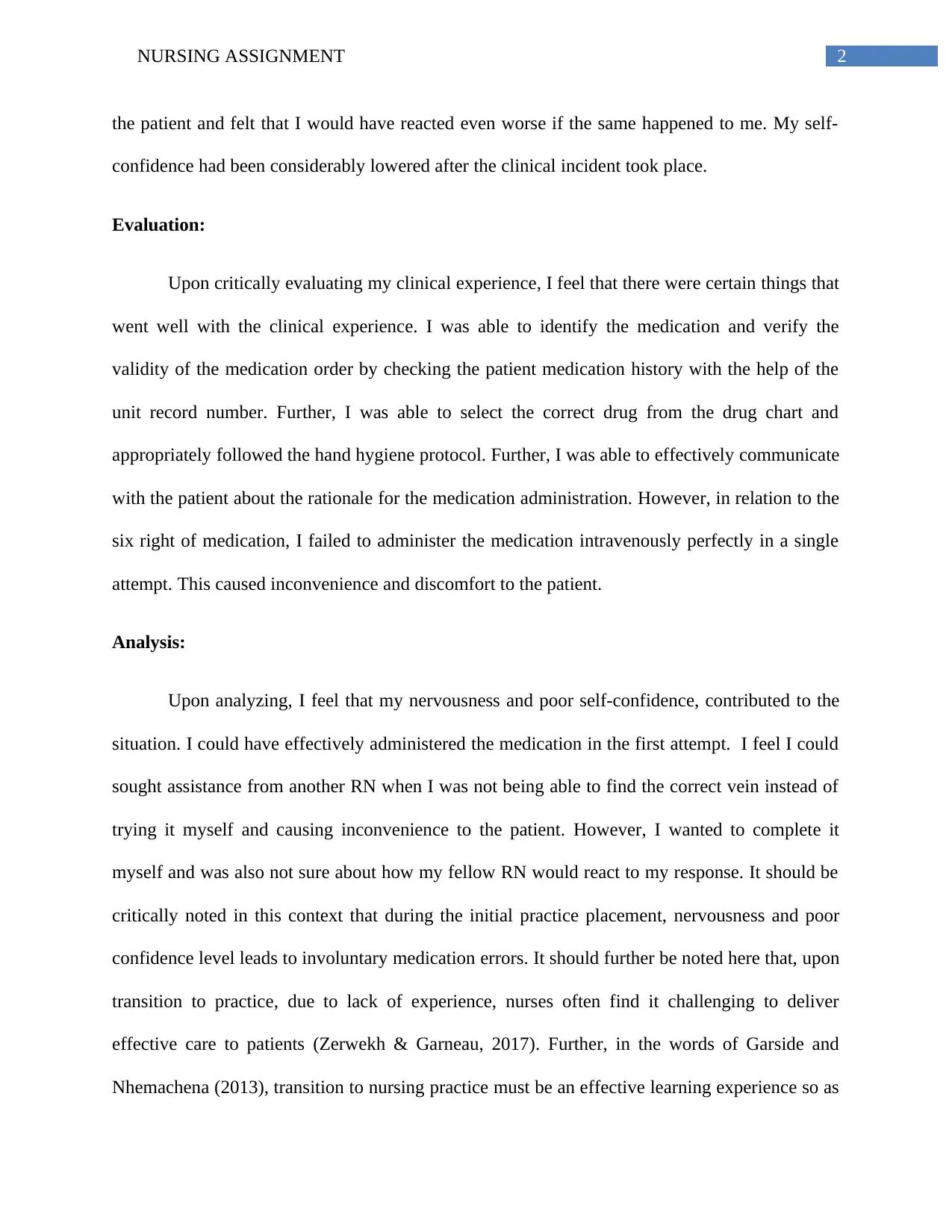
2NURSING ASSIGNMENT
the patient and felt that I would have reacted even worse if the same happened to me. My self-
confidence had been considerably lowered after the clinical incident took place.
Evaluation:
Upon critically evaluating my clinical experience, I feel that there were certain things that
went well with the clinical experience. I was able to identify the medication and verify the
validity of the medication order by checking the patient medication history with the help of the
unit record number. Further, I was able to select the correct drug from the drug chart and
appropriately followed the hand hygiene protocol. Further, I was able to effectively communicate
with the patient about the rationale for the medication administration. However, in relation to the
six right of medication, I failed to administer the medication intravenously perfectly in a single
attempt. This caused inconvenience and discomfort to the patient.
Analysis:
Upon analyzing, I feel that my nervousness and poor self-confidence, contributed to the
situation. I could have effectively administered the medication in the first attempt. I feel I could
sought assistance from another RN when I was not being able to find the correct vein instead of
trying it myself and causing inconvenience to the patient. However, I wanted to complete it
myself and was also not sure about how my fellow RN would react to my response. It should be
critically noted in this context that during the initial practice placement, nervousness and poor
confidence level leads to involuntary medication errors. It should further be noted here that, upon
transition to practice, due to lack of experience, nurses often find it challenging to deliver
effective care to patients (Zerwekh & Garneau, 2017). Further, in the words of Garside and
Nhemachena (2013), transition to nursing practice must be an effective learning experience so as
the patient and felt that I would have reacted even worse if the same happened to me. My self-
confidence had been considerably lowered after the clinical incident took place.
Evaluation:
Upon critically evaluating my clinical experience, I feel that there were certain things that
went well with the clinical experience. I was able to identify the medication and verify the
validity of the medication order by checking the patient medication history with the help of the
unit record number. Further, I was able to select the correct drug from the drug chart and
appropriately followed the hand hygiene protocol. Further, I was able to effectively communicate
with the patient about the rationale for the medication administration. However, in relation to the
six right of medication, I failed to administer the medication intravenously perfectly in a single
attempt. This caused inconvenience and discomfort to the patient.
Analysis:
Upon analyzing, I feel that my nervousness and poor self-confidence, contributed to the
situation. I could have effectively administered the medication in the first attempt. I feel I could
sought assistance from another RN when I was not being able to find the correct vein instead of
trying it myself and causing inconvenience to the patient. However, I wanted to complete it
myself and was also not sure about how my fellow RN would react to my response. It should be
critically noted in this context that during the initial practice placement, nervousness and poor
confidence level leads to involuntary medication errors. It should further be noted here that, upon
transition to practice, due to lack of experience, nurses often find it challenging to deliver
effective care to patients (Zerwekh & Garneau, 2017). Further, in the words of Garside and
Nhemachena (2013), transition to nursing practice must be an effective learning experience so as
⊘ This is a preview!⊘
Do you want full access?
Subscribe today to unlock all pages.

Trusted by 1+ million students worldwide
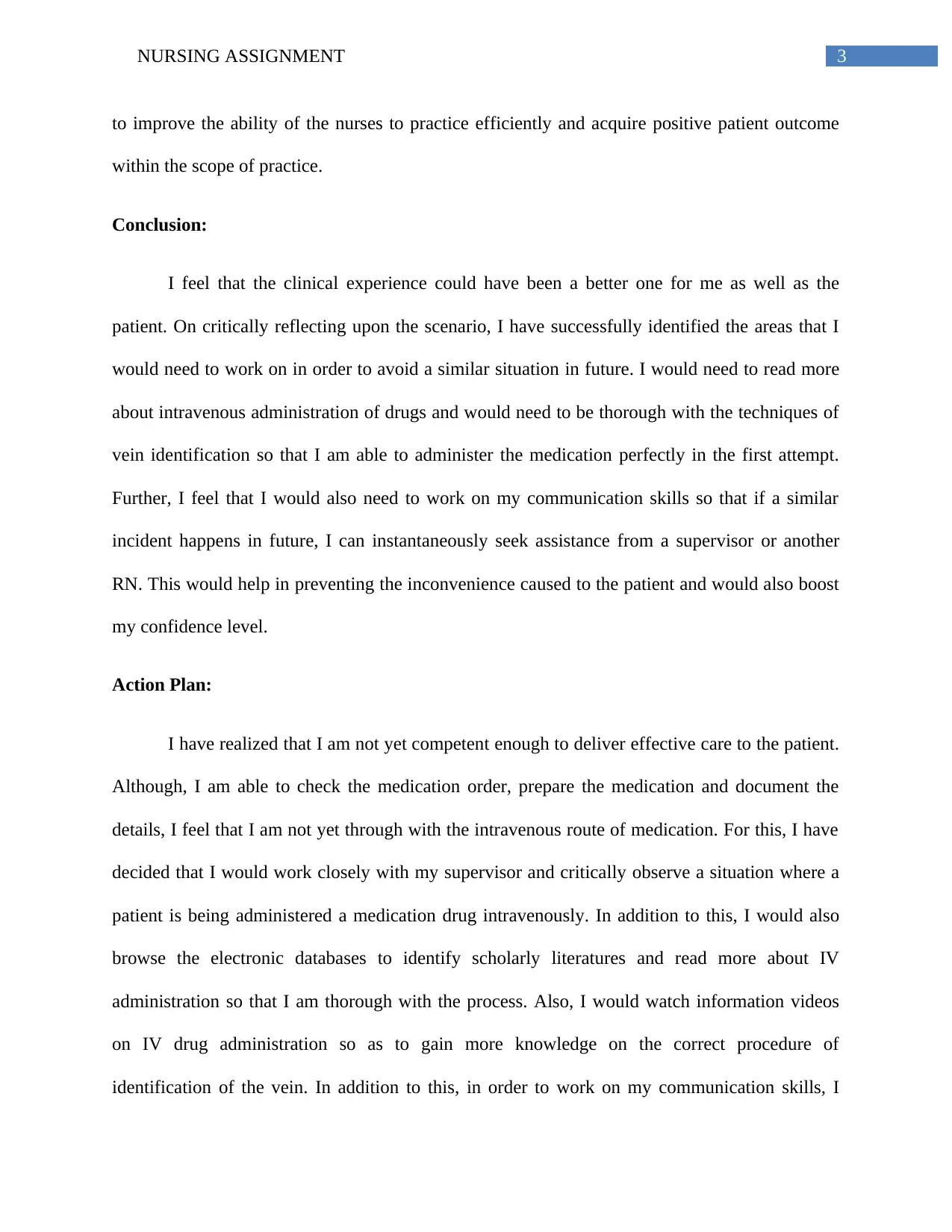
3NURSING ASSIGNMENT
to improve the ability of the nurses to practice efficiently and acquire positive patient outcome
within the scope of practice.
Conclusion:
I feel that the clinical experience could have been a better one for me as well as the
patient. On critically reflecting upon the scenario, I have successfully identified the areas that I
would need to work on in order to avoid a similar situation in future. I would need to read more
about intravenous administration of drugs and would need to be thorough with the techniques of
vein identification so that I am able to administer the medication perfectly in the first attempt.
Further, I feel that I would also need to work on my communication skills so that if a similar
incident happens in future, I can instantaneously seek assistance from a supervisor or another
RN. This would help in preventing the inconvenience caused to the patient and would also boost
my confidence level.
Action Plan:
I have realized that I am not yet competent enough to deliver effective care to the patient.
Although, I am able to check the medication order, prepare the medication and document the
details, I feel that I am not yet through with the intravenous route of medication. For this, I have
decided that I would work closely with my supervisor and critically observe a situation where a
patient is being administered a medication drug intravenously. In addition to this, I would also
browse the electronic databases to identify scholarly literatures and read more about IV
administration so that I am thorough with the process. Also, I would watch information videos
on IV drug administration so as to gain more knowledge on the correct procedure of
identification of the vein. In addition to this, in order to work on my communication skills, I
to improve the ability of the nurses to practice efficiently and acquire positive patient outcome
within the scope of practice.
Conclusion:
I feel that the clinical experience could have been a better one for me as well as the
patient. On critically reflecting upon the scenario, I have successfully identified the areas that I
would need to work on in order to avoid a similar situation in future. I would need to read more
about intravenous administration of drugs and would need to be thorough with the techniques of
vein identification so that I am able to administer the medication perfectly in the first attempt.
Further, I feel that I would also need to work on my communication skills so that if a similar
incident happens in future, I can instantaneously seek assistance from a supervisor or another
RN. This would help in preventing the inconvenience caused to the patient and would also boost
my confidence level.
Action Plan:
I have realized that I am not yet competent enough to deliver effective care to the patient.
Although, I am able to check the medication order, prepare the medication and document the
details, I feel that I am not yet through with the intravenous route of medication. For this, I have
decided that I would work closely with my supervisor and critically observe a situation where a
patient is being administered a medication drug intravenously. In addition to this, I would also
browse the electronic databases to identify scholarly literatures and read more about IV
administration so that I am thorough with the process. Also, I would watch information videos
on IV drug administration so as to gain more knowledge on the correct procedure of
identification of the vein. In addition to this, in order to work on my communication skills, I
Paraphrase This Document
Need a fresh take? Get an instant paraphrase of this document with our AI Paraphraser
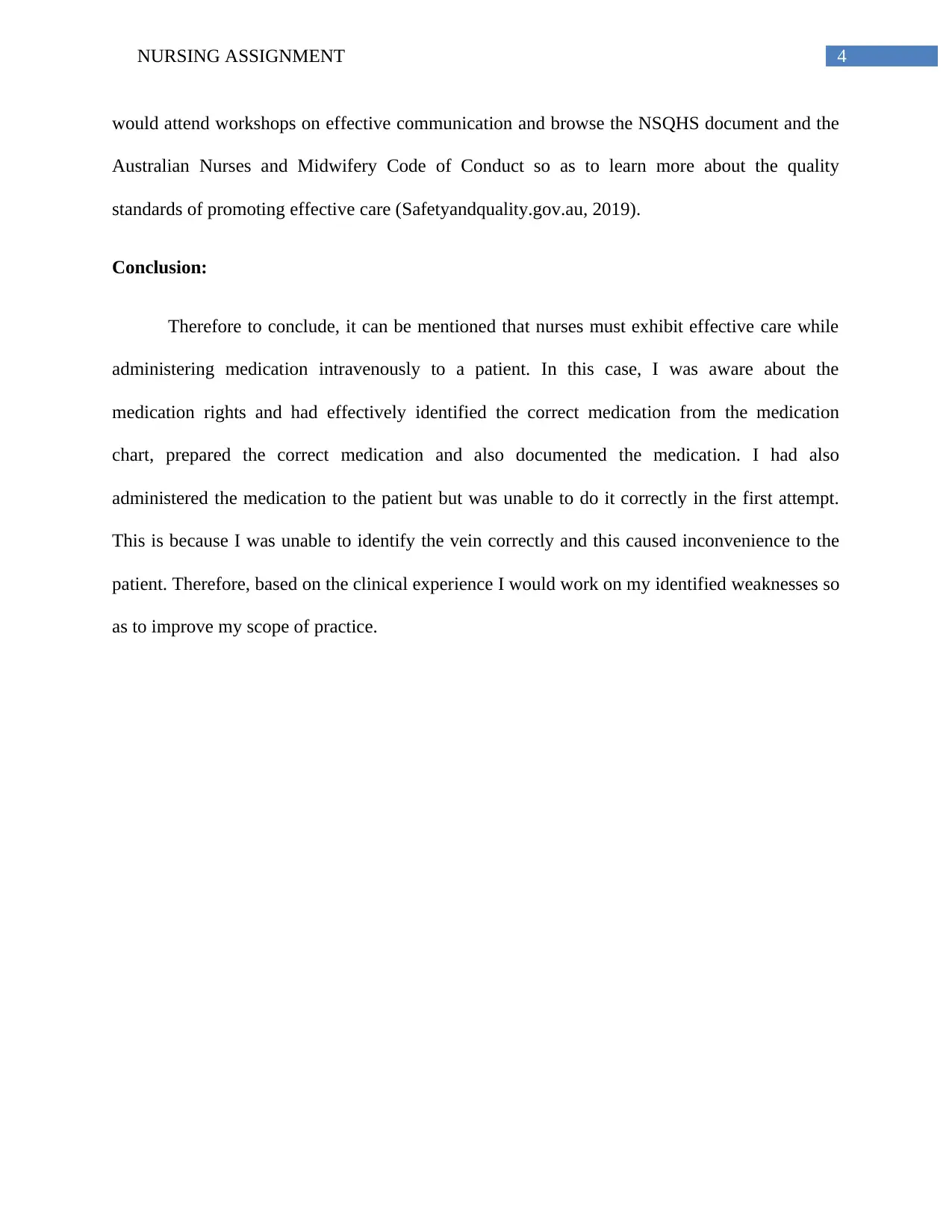
4NURSING ASSIGNMENT
would attend workshops on effective communication and browse the NSQHS document and the
Australian Nurses and Midwifery Code of Conduct so as to learn more about the quality
standards of promoting effective care (Safetyandquality.gov.au, 2019).
Conclusion:
Therefore to conclude, it can be mentioned that nurses must exhibit effective care while
administering medication intravenously to a patient. In this case, I was aware about the
medication rights and had effectively identified the correct medication from the medication
chart, prepared the correct medication and also documented the medication. I had also
administered the medication to the patient but was unable to do it correctly in the first attempt.
This is because I was unable to identify the vein correctly and this caused inconvenience to the
patient. Therefore, based on the clinical experience I would work on my identified weaknesses so
as to improve my scope of practice.
would attend workshops on effective communication and browse the NSQHS document and the
Australian Nurses and Midwifery Code of Conduct so as to learn more about the quality
standards of promoting effective care (Safetyandquality.gov.au, 2019).
Conclusion:
Therefore to conclude, it can be mentioned that nurses must exhibit effective care while
administering medication intravenously to a patient. In this case, I was aware about the
medication rights and had effectively identified the correct medication from the medication
chart, prepared the correct medication and also documented the medication. I had also
administered the medication to the patient but was unable to do it correctly in the first attempt.
This is because I was unable to identify the vein correctly and this caused inconvenience to the
patient. Therefore, based on the clinical experience I would work on my identified weaknesses so
as to improve my scope of practice.
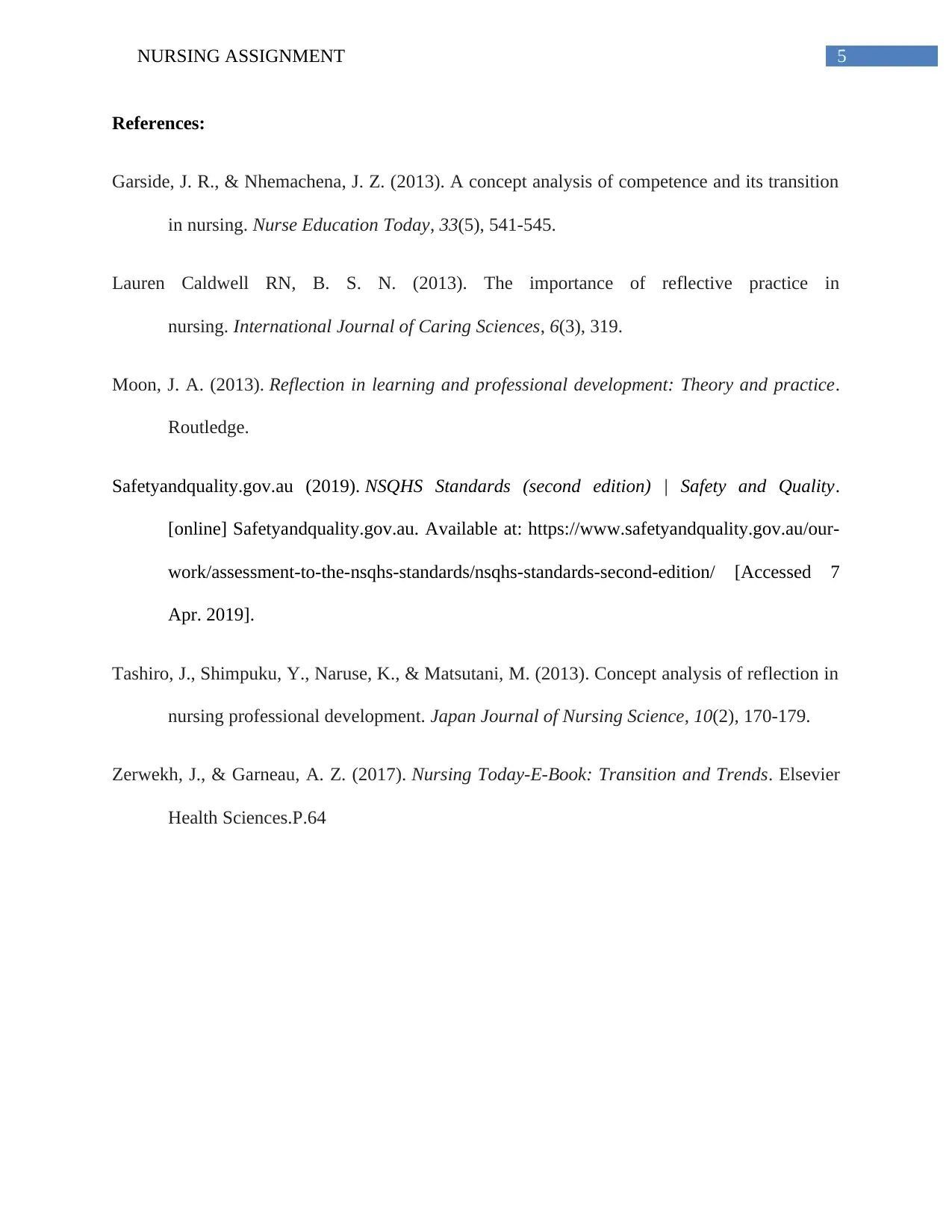
5NURSING ASSIGNMENT
References:
Garside, J. R., & Nhemachena, J. Z. (2013). A concept analysis of competence and its transition
in nursing. Nurse Education Today, 33(5), 541-545.
Lauren Caldwell RN, B. S. N. (2013). The importance of reflective practice in
nursing. International Journal of Caring Sciences, 6(3), 319.
Moon, J. A. (2013). Reflection in learning and professional development: Theory and practice.
Routledge.
Safetyandquality.gov.au (2019). NSQHS Standards (second edition) | Safety and Quality.
[online] Safetyandquality.gov.au. Available at: https://www.safetyandquality.gov.au/our-
work/assessment-to-the-nsqhs-standards/nsqhs-standards-second-edition/ [Accessed 7
Apr. 2019].
Tashiro, J., Shimpuku, Y., Naruse, K., & Matsutani, M. (2013). Concept analysis of reflection in
nursing professional development. Japan Journal of Nursing Science, 10(2), 170-179.
Zerwekh, J., & Garneau, A. Z. (2017). Nursing Today-E-Book: Transition and Trends. Elsevier
Health Sciences.P.64
References:
Garside, J. R., & Nhemachena, J. Z. (2013). A concept analysis of competence and its transition
in nursing. Nurse Education Today, 33(5), 541-545.
Lauren Caldwell RN, B. S. N. (2013). The importance of reflective practice in
nursing. International Journal of Caring Sciences, 6(3), 319.
Moon, J. A. (2013). Reflection in learning and professional development: Theory and practice.
Routledge.
Safetyandquality.gov.au (2019). NSQHS Standards (second edition) | Safety and Quality.
[online] Safetyandquality.gov.au. Available at: https://www.safetyandquality.gov.au/our-
work/assessment-to-the-nsqhs-standards/nsqhs-standards-second-edition/ [Accessed 7
Apr. 2019].
Tashiro, J., Shimpuku, Y., Naruse, K., & Matsutani, M. (2013). Concept analysis of reflection in
nursing professional development. Japan Journal of Nursing Science, 10(2), 170-179.
Zerwekh, J., & Garneau, A. Z. (2017). Nursing Today-E-Book: Transition and Trends. Elsevier
Health Sciences.P.64
⊘ This is a preview!⊘
Do you want full access?
Subscribe today to unlock all pages.

Trusted by 1+ million students worldwide
1 out of 6
Related Documents
Your All-in-One AI-Powered Toolkit for Academic Success.
+13062052269
info@desklib.com
Available 24*7 on WhatsApp / Email
![[object Object]](/_next/static/media/star-bottom.7253800d.svg)
Unlock your academic potential
Copyright © 2020–2025 A2Z Services. All Rights Reserved. Developed and managed by ZUCOL.





